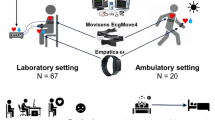Abstract
Witthe rapid growth in the number of elderly people in the population, interest in health monitoring is increasing. Therefore the development of an unconstrained and non-invasive vital signs measurement system could be important for monitoring health status at home or in hospitals or nursing facilities. A simple system is proposed for measuring heart-beat and respiration periods for home healthcare. This was achieved with a phonocardiographic (PCG) sensor set on a water-mat or air-mat. The PCG sensor was an acceleration sensor that extracted the vibration of the mat caused by heart-beat and respiration. By calculating an autocorelation function of the fully rectifiedsensor output or by local pattern matching between the rectifiecbutput and a reference signal (pre-memorised for each subject), the system measured the average and instantaneous periods of both heart-beat and respiratin. Results showed that these periods were measured to a similar level of accuracy as for the electrocardiogram and thermistor respiration pickup. The comparative accuracies were within the following ranges: average heartbeat 0.19% to 0.67%, instantaneous heartbeat 0.53%to 1.15%, average respiration 0.51% to 2.17% and instantaneous respiration 2.51% to 5.20%.
Similar content being viewed by others
References
Antoniou, A. (1979): ‘Digital filters; analysis and design’ (McGraw-Hill Book Co., 1979)
Ishijima, M. (1997): ‘Cardiopulmonary monitoring by textile electrodes without subject-awareness of being monitored’,Med. Biol. Eng. Comput.,35, pp. 685–690
Ishijima, M., andTogawa, T. (1989): ‘Observation of electrocardiograms through tap water’,Clin. Phys. Physiol. Meas.,10, pp. 171–175
Nakai, H., Watanabe, M., Miyake, Y., Takada, K., Yamashita, K., Shinmori, H., andIshihara, K. (2000): ‘Automatic respiration monitoring system by time-varying image analysis’,T.IECE,J83-D-2(1), pp. 280–288
Nihon-Koden Co., Ltd. (1998): ‘Sensor total catalog’, Nihon Koden Co. Ltd. CAT.NO.880-600
Nishida, Y., Takeda, M., Mori, T., Mizoguchi, H., andSato, T. (1998): ‘Unrestrained and non-invasive monitoring of human's respiration and posture in sleep using pressure sensors’,JRSJ,16, pp. 705–711
Uozumi, Z., Sakamoto, T., andUeda, H. (1977): ‘The normal heart sounds in the Japanese. The normal phonocardiogram’,Jpn. Heart J.,2, pp. 426–442
Watanabe, H., andWatanabe, K. (1999): ‘Non-invasive sensing of cardiobilistram, respiration, snoring, body movement and coughing of a patient on the bed’,T.SICE,35, pp. 1012–1019
Author information
Authors and Affiliations
Corresponding author
Rights and permissions
About this article
Cite this article
Tanaka, S., Matsumoto, Y. & Wakimoto, K. Unconstrained and non-invasive measurement of heart-beat and respiration periods using a phonocardiographic sensor. Med Bio Eng Comput 40, 246–252 (2002). https://doi.org/10.1007/BF02348132
Received:
Accepted:
Issue Date:
DOI: https://doi.org/10.1007/BF02348132




